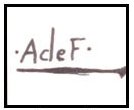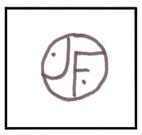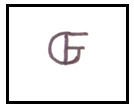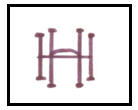
About UsThe Numismatic Bibliomania Society is a non-profit organization promoting numismatic literature. For more information please see our web site at coinbooks.org SubscriptionsThose wishing to become new E-Sylum subscribers (or wishing to Unsubscribe) can go to the following web page link MembershipThere is a membership application available on the web site Membership Application To join, print the application and return it with your check to the address printed on the application. Membership is only $15 to addresses in the U.S., $20 for First Class mail, and $25 elsewhere. For those without web access, write to: David M. Sundman, Secretary/TreasurerNumismatic Bibliomania
Society AsylumFor Asylum mailing address changes and other membership questions, contact David at this email address: dsundman@LittletonCoin.com SubmissionsTo submit items for publication in The E-Sylum, just Reply to this message, or write to the Editor at this address: whomren@coinlibrary.com
BUY THE BOOK BEFORE THE COINYou won't regret it! |
- WAYNE'S WORDS: THE E-SYLUM AUGUST 15, 2010
- NBS ACTIVITIES AT THE 2010 BOSTON ANA CONVENTION
- NEW BOOK: THE ENCYCLOPEDIA OF ROMAN IMPERIAL COINS, SECOND EDITION
- BOOK REVIEW: MODERN UNITED STATES PROOF COIN SETS, SECOND EDITION
- BOOK REVIEW: MEDALLIC PORTRAITS OF ADMIRAL VERNON
- BOOK REVIEW: CONFEDERATE ISSUERS OF TRAIN AND HOER NOTES
- REPORTS FROM THE 2010 BOSTON ANA CONVENTION
- THE RITTENHOUSE SOCIETY MEETING AT THE 2010 BOSTON ANA CONVENTION
- ALAN WEINBERG ON THE 2010 BOSTON ANA CONVENTION
- QUIZ ANSWER: MONOGRAMS OF AMERICAN COIN AND MEDAL ARTISTS
- GROUSE HUNTING SEASON: MORE ON AUDUBON'S FIRST ENGRAVED ILLUSTRATION
- IS IT REAL? A 1913 DENVER MINT SHIPPING CRATE
- RESEARCHING THE COPYRIGHT STATUS OF BOOKS
- MORE ON THE JUDGE JAMES P. GORTER MEDAL
- QUERY: ROOSEVELT UNIVERSITY COURSE IN NUMISMATICS
- TOM DELOREY CONGRATULATES DAVID T. ALEXANDER
- TOYOKORO, JAPAN GIVES GOLD OBAN COIN TO SISTER CITY
- GOLD MNAIEION OF PTOLEMY V UNEARTHED IN ISRAEL
- EGYPTIAN MUSEUM EXHIBIT: COINS THROUGH THE AGES
- A GLIMPSE OF PAPER MONEY FROM THE TITANIC
- BBC ARTICLE ON THE UNUSED U.S DOLLAR COINS
- HEAD OF BANKNOTE FIRM DE LA RUE RESIGNS OVER PAPER QUALITY
- DIRTY MONEY: BANKNOTES REFLECT NATIONAL WEALTH
- FEATURED WEB SITE: THE AMERICAN NUMISMATIC ASSOCIATION
WAYNE'S WORDS: THE E-SYLUM AUGUST 15, 2010

Among our new subscribers this week are Glenn Schinke, courtesy of Alan V. Weinberg, Edwin Bevens, Grace Proctor, Karin Oquist, and William Hyder. Welcome aboard! We now have 1,373 subscribers.
This week we open with a sample of the many great photographs taken by Dan Gosling at NBS activities at this past week's ANA convention in Boston. Next up is a new book announcement and three book reviews.
But we're not done with the ANA convention - next up are reports from Dick Johnson, Dennis Tucker, Pete Smith, Joel Orosz and Alan Weinberg. Thanks, everyone, for the timely reporting and great stories and photos. What a blockbuster week!
In topics opened last week we have the results of my quiz based on Dick Johnson's new book on monograms or coin and medal designers, and another sighting of James Audubon's now-famous grouse image.
Other topics include the James Gorter medal, the Roosevelt University course in numismatics, and the gift of a gold oban from Japan.
To learn about hoers, the Rittenhouse Society, George Washington's set of silver Comitia Americana medals, and paper money recovered from the wreck of the Titanic, read on. Have a great week, everyone!
Wayne Homren
Numismatic Bibliomania Society
NBS ACTIVITIES AT THE 2010 BOSTON ANA CONVENTION
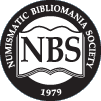 Dan Gosling provided some great photos of NBS activities at this week's ANA convention in Boston. Thanks!
Dan Gosling provided some great photos of NBS activities at this week's ANA convention in Boston. Thanks!
The Numismatic Bibliomania Society Symposium took place on Thursday the 12th at 11:30 am. Author John W. Adams spoke on "Medallic Portraits of Admiral Vernon".
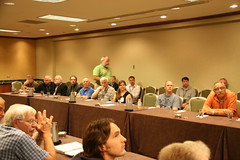
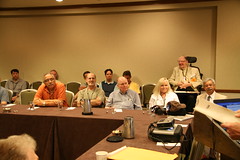
The regular NBS meeting was held on Friday, August 13 from 11:30 am to 1:00 pm at the Massachusetts Historical Society. The featured speaker was Frank Campbell, who spoke on some of his favorite memories of books and personalities during his outstanding career as librarian of the American Numismatic Society. Below are Secretary-Treasurer Dave Sundman (left) and Frank Campbell (right).
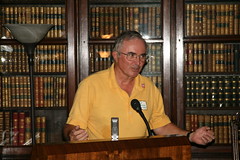
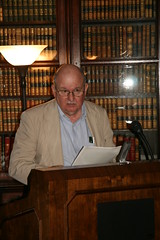
Below are Len Augsburger, Brad Karoleff, and Joel Orosz.
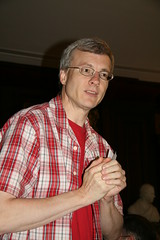
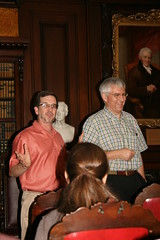
I understand some awards were instituted and awarded at the meeting. Here are George Kolbe and John Adams.
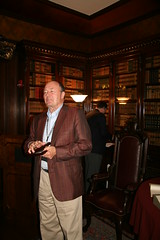
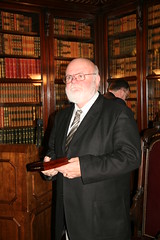
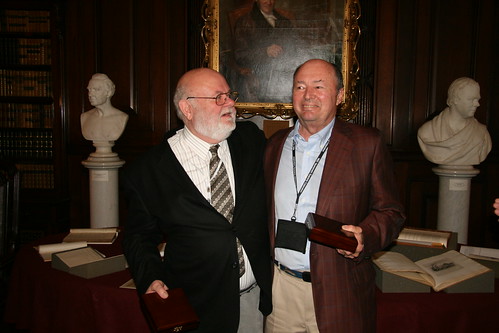
We may have some more reports in next week's issue, as well as in the next issue of our print journal, The Asylum. What a great week for numismatic literature!
THE BOOK BAZARRE
NEW BOOK: THE ENCYCLOPEDIA OF ROMAN IMPERIAL COINS, SECOND EDITION
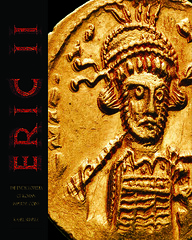 Rasiel Suarez is pleased to announce the release of the second edition of 2005's Encyclopedia of Roman Imperial Coins. While keeping the same general format as the well-received original book, this second edition has been vastly expanded to include the entries of all major reference books on the period covered while extending this coverage through the thousand-year reign of the Byzantine empire.
Rasiel Suarez is pleased to announce the release of the second edition of 2005's Encyclopedia of Roman Imperial Coins. While keeping the same general format as the well-received original book, this second edition has been vastly expanded to include the entries of all major reference books on the period covered while extending this coverage through the thousand-year reign of the Byzantine empire.
New to the second edition is an effort to compile market rarity and pricing through the sales of hundreds of thousands of auction sales. While already a strong feature of the first edition, there has also been an emphasis placed on upgrading the color photography used. Biographies on the many rulers of the Roman empire have been expanded and draw on contemporary literature as well as new research to provide concise yet informative introductions to each section.
More information available on the publisher's website at http://www.dirtyoldbooks.com. 1,481pp, $150 available October 2010.
BOOK REVIEW: MODERN UNITED STATES PROOF COIN SETS, SECOND EDITION
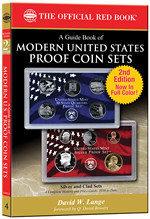 A Guide Book of Modern United States Proof Coin Sets (Second Edition) by David W. Lange, Whitman 2010; 256 pages; $19.95; reviewed by Michael E. Marotta.
A Guide Book of Modern United States Proof Coin Sets (Second Edition) by David W. Lange, Whitman 2010; 256 pages; $19.95; reviewed by Michael E. Marotta.
We learn to expect perfection. America's modern coinage and the current series of Whitman books both validate that presentiment. Those streams find their confluence in this book. The stunning photographs and enlightening narrative do justice to the modern products of the U.S. Mint.
Lange established the proper perspective by only touching on the earliest history of proof coinage. Even discussing the products of the U.S. Mint in the 19th century the author only paves the way for the topic. For that other philosophical discussion the numismatist will turn to Walter Breen's Encyclopedia of US & Colonial Proof Coins.)
Lange chronicles the unsteady progress in the 20th century, as the Mint, always a political institution, guessed (often incorrectly) at the needs of collectors avid for the best possible examples of the coiner's art. Lange includes his own story. Back when computerized commerce depended on punched cards, he took his chances, waiting months to discover whether or not his package would include frosty proofs or merely brilliant.
Like all books in this series, this one tabulates pricing by appropriate grades. For the year 1962, Proof 66 Ultra Cameo and Proof 67 Ultra Cameo are as good as it gets. For 1982, nothing less than Proof 69 Ultra Cameo is worth tallying. In addition, for each year, the book provides the mintage, packaging, original price and approximate market price for a common uncertified example.
As always, the bonus is the author's commentary discussing the details of each production run and its place in the market today. For completeness in the series, Lange includes the Special Mint Sets 1965-1967. As in years past, the Mint was having a hard time keeping up with production. (Mint Director Eva Adams blamed collectors for hoarding coins.) No proof sets were produced. The earlier lacunae are also explained.
Often, those of us whose age rounds up to 100 complain that modern coins lack the grandeur of the classical era. We miss the Seated Liberty, Mercury, and the Buffalo. A few minutes reflecting on the perfect presentation of State Quarters and commemorative dollars such as the Smithsonian, the Lief Erikson and the Wright Brothers, may bring a new perspective. If it does not, the book closes with an Appendix that illustrates early proofs from the Classic Head Half Cent to the 1907 Saint Gaudens Double Eagle.
As Dave Bowers notes in his Foreword,
Sometimes a small and scarcely noticeable die detail can mean a large difference in value... Distinctions that were either not recognized or not emphasized - such as doubled dies and deep cameo contrasts - are described in detail. Although I consider myself to be fairly conversant with modern Proof coinage, until reading the first edition of this book, I did not know of the complexity involved! Now I know that even among sets of the past several decades, two adjacent dates can have widely different characteristics as to contrast, die die sharpness, and the like.
The color photographs are very attractive, and the book's compact size makes it easy for a collector to carry along to coin shows. Bibliophiles will compare and contrast this work with United States Proof and Mint Sets by Bill Gale and Ron Guth. I have the 2002 edition (is there a later one)? Obviously the color photos on the new Lange work are a differentiator over the largely black-and-white images in that book.
But one feature of the Gale/Guth work I miss is the four-page gallery of color photos showing the evolution of Proof set packaging year-by-year. There's a place for both of these books in a numismatic library, and these will sit side-by-side on my shelf for ready reference. Congratulations to Dave Lange and Whitman for a great update to a great book. -Editor
BOOK REVIEW: MEDALLIC PORTRAITS OF ADMIRAL VERNON
Medals Sometimes Lie
by John W. Adams and Dr. Fernando Chao (h)
with the collaboration of Anne E. Bentley
 I was hoping to write this review BEFORE this week's ANA convention, but it was not to be. Last's week's volume of E-Sylum correspondence kept me editing until late Sunday, just before publication. But with so many of you attending the convention, my email workload was pretty light this week, freeing up some time to write something myself.
I was hoping to write this review BEFORE this week's ANA convention, but it was not to be. Last's week's volume of E-Sylum correspondence kept me editing until late Sunday, just before publication. But with so many of you attending the convention, my email workload was pretty light this week, freeing up some time to write something myself.
By now many of you will have attended author Adams' presentation about the book at the Numismatic Bibliomania Society Symposium on Thursday the 12th. I don't know how I could top a presentation from the author himself or the remarks of prior reviewers such as Joel Orosz, who wrote:
“Medallic Portraits of Admiral Vernon does such a superb job of defining the previously indefinable, the only numismatic book in English to which it can appropriately be compared is Sylvester Sage Crosby's Early Coins of America.”
But here goes.
As previously noted (see below for Alan Luedeking's item from a 2005 E-Sylum), some fourteen numismatic authors from around the world have previously tackled the subject. What does Mr. Adams' work add to the canon? Well, I have to agree with the dust jacket text, which states:
Despite the plethora of available material, there are two needs that have not been met in previous accounts. The first is for images. Because of the small differences between many of the varieties, words along inevitably fail to support attributions, leading to confusion, and inaccuracies.
The second need has been for a balanced history of the events. English authors have tended to view Admiral Vernon as a knight in shining armor. Spanish-speaking authors have seen Vernon as a pirate and an overrated one at that. Using source documents drawn from both sides of the conflict, we have attempted to provide a balanced view.
Earlier works that I've seen pictured only a few of the medals, and often poorly at that. The color illustrations throughout the Adams book certainly remedy that problem, although my aging eyes would have appreciated some enlargements to enable easier viewing of some details of these intricate medals.
As a bibliophile I greatly appreciate the Prior Art chapter, which enumerates and describes all fourteen major earlier works on the topic, from 1835 to 1966. The four-page Bibliography references a wide range of books, articles, correspondence and auction catalogs.
Cabinets visited include the American Numismatic Society, British Museum, Massachusetts Historical Society, Museum of Fine Arts, Boston, National maritime Museum, Greenwich, Royal Coin Cabinet, Stockholm, The Hermitage, St. Petersburg, the U.S. Naval Academy Museum, and Yale University. Several E-Sylum readers also contributed by submitting their private collections to the census, including Syd Martin, David Menchell and John Sallay.

Online information is limited, but the bibliography notes Plowman's Coins-of-Panama.Com (www.coins-of-panama.com/vernon.html). The above image of a typical medal is taken from the site.
The battles commemorated by the Admiral Vernon medals took place between November 1739 and April 1741 as England and Spain struggled for control of the New World. Most are related to events at Portobello and Cartagena. The extensive History of Events chapter (p13-31) provides a very interesting review of the events and personalities involved - a must-read for understanding the background of the medals.
The core of the book is The Medals chapter, comprising pages 33-200. Each medal is illustrated obverse and reverse, with size, composition and rarity information along with text descriptions of the legends and devices.
Appendix I holds tables of concordances with the major prior catalog systems for Admiral Vernon medals, including Betts, Ferrari, Milford Haven, Medina and Grueber (Medallic Illustrations of the History of Great Britain and Ireland).
Collectors and bibliophiles are getting a quite substantial book for their money. The large 240-page hard covered book is coffee-table sized (12" by 9"), bound in grey cloth, with a beautiful full-color dust jacket.
To order, contact publishers Kolbe & Fanning, Gahanna, Ohio, 2010. $95.00 plus $5.00 shipping in the United States, $25 to Canada and $40.00 elsewhere. To visit the firm's web site, see: www.numislit.com.
To read the earlier E-Sylum article, see: NEW BOOK: MEDALLIC PORTRAITS OF ADMIRAL VERNON (www.coinbooks.org/esylum_v13n16a05.html)
To read Alan Luedeking's note on earlier authors, see: ON JOHN ADAMS' ADMIRAL VERNON MEDALS WORK (www.coinbooks.org/esylum_v08n06a21.html)
BOOK REVIEW: CONFEDERATE ISSUERS OF TRAIN AND HOER NOTES
of Train and Hoer Notes
An Alphabetical Images Key and Descriptions
of the Endorsements on and Issuers of
T-39, T-40, & T-41 Confederate Treasury Notes
 So what are Train and Hoer Notes? We all know what trains are, but "hoer" is not a word that often comes up in conversation. When I first saw "Hoer Notes" in the title of this book, I'll have to admit it reminded me of "Boer Notes" of the South Africa. But in this case "Hoer" means "one who hoes" - and for those of you who listen to too much rap music, it's not THOSE kind of hoes, either. These hoes are farming implements used to break up the soil for planting.
So what are Train and Hoer Notes? We all know what trains are, but "hoer" is not a word that often comes up in conversation. When I first saw "Hoer Notes" in the title of this book, I'll have to admit it reminded me of "Boer Notes" of the South Africa. But in this case "Hoer" means "one who hoes" - and for those of you who listen to too much rap music, it's not THOSE kind of hoes, either. These hoes are farming implements used to break up the soil for planting.
Specifically, this book concerns three types of notes of the Confederate States of America, known by their images of a Train and a Hoer.
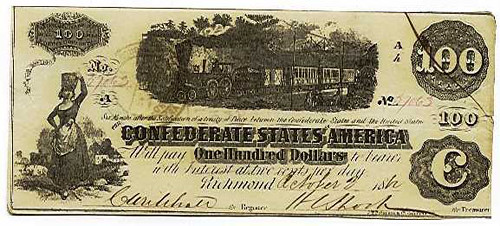
A train note (T-40) T-39 is similar.
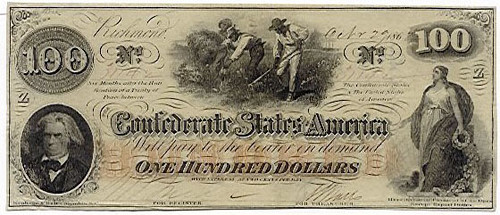
A Hoer note (T-41)
According to the book's introduction:
Confederate Treasury notes known to collectors as T-39, T-40 and T-41 were hand-dated on the front of the note by the Treasury Department in Richmond, Virginia, from May 9th, 1862 to January 8th, 1863. These notes bore interest at a rate of 7.3% from the date of issue, which did not accrue until the note was actually issued for commerce. Used by the government to finance the war effort, we can sometimes observe endorsements by military and civil issues on the back of these $100 notes. The book illustrates many of these endorsements, the date of issue, and sometimes the place of issue, all of which provide clues for the research of these Civil War Confederate issuers.
Each entry in the book illustrates the front and back of a note in color along with the name and biographical information about the issuer. Some were military agents, some civilian. Information is scanty on many of them, but several have lengthy biographies and others include diary entries or letters in the words of the issuers themselves.
The 286-page book is an impressive compilation of information about these notes. It is the work of a dedicated group of collectors calling themselves The Trainmen. Founded by Col Crutchfield Williams as a group of five in 1998, the group grew to 38 contributing members.
The book is a wonderfully useful work, taking the guesswork out of deciphering faded handwritten signatures on the notes, and helping to bring alive the history behind them.
It's not without its flaws, however. It fails my "back of the book" test, having no index or bibliography whatsoever. It's a glaring omission that the book only mentions Grover Criswell once in passing, and never explicitly explains that "T-39", "T-40" and "T-41" are references to the Criswell numbering system. My other peeve, albeit a minor one, is that the book uses the coin terms "obverse" and "reverse" to refer to the face and back of the notes.
This is not likely to be the first book picked up by a novice collector of Confederate notes, so those problems are minor. Anyone who already collects these notes will understand the terms. Overall, this is a great new reference work for collectors and researchers of U.S. Civil War numismatics. To order, contact:
 Mike McNeil
Mike McNeil
CCCA
321 Seventh Street
Mead, CO 80542-4574
mmcneil@k2cable.net
720-308-5740
To read the earlier E-Sylum article, see: NEW BOOK: CONFEDERATE ISSUERS OF TRAIN AND HOER NOTES (www.coinbooks.org/club_nbs_esylum_v13n30a03.html)
THE BOOK BAZARRE
REPORTS FROM THE 2010 BOSTON ANA CONVENTION
Dick Johnson submitted this quick report on Quality and Quantity at the Boston ANA.
Quantity: Number of dealers: high. Number of Mints: down. Number numismatic book dealers: same three (bless them for dragging all that inventory, but should also mention Wizard Coin Supply for a large display of books in print). Number of Auctions: high. Show attendance: less than I expected. Exhibits: mixed, some high, some low. Numismatic lectures: same number it seems but very well attended. (Thank goodness collectors still want to learn!)
Quality: Dealer stock: very high. Auction items: very high. Numismatic lectures: extremely high quality. Auction attendance (someone else must report on this and auction sales results).
The economy definitely affected the Boston ANA. Dealers seemed to bring more stock of higher priced items. This was the place to sell it. But many carried unsold items back home.
Book and supply items had a tax-free day on Saturday. (I bought, I sold.)
Introduction of my new book -- Monographs of Coin & Medal Artists -- found a great reception. Had to open a second box of four I brought to the show.
It seems the profitability of conducting conventions is great for the ANA, as evidenced by increasing the number of major shows from two to three a year, by adding a new Spring Show.
More next week.
Late Friday night Dennis Tucker of Whitman publishing sent this quick report from the Boston ANA convention:
You're missing a fun ANA! It's been a very successful and productive show for me, from a publisher's perspective. I've met with current Whitman authors, talked with potential new authors (writers with manuscript proposals), and worked on planning for several longterm projects.
Our autograph sessions have been popular --- Fred Reed was kept busy signing copies of his Abraham Lincoln book, and he later told me he was asked to speak at a Lincoln forum as a result of his meet-and-greet. Bob Leonard's Curious Currency remains a nice popular seller and attention-getter. 100 Greatest Error Coins has been the buzz of the bourse, and it looks like we'll sell out of the show's inventory before the convention closes.
At the Numismatic Literary Guild awards banquet, Whitman authors who walked away with prizes include Jeff Garrett, Q. David Bowers, David MacDonald, and Robert Leonard. (Not to mention David Lange, Rick Snow, and Fred Reed, for various non-Whitman works.) QDB's Whitman Encyclopedia of U.S. Paper Money won "Book of the Year" (the work most likely to have an impact on numismatics). This is our second year in a row to earn the top prize.
On a non-literary note, I added a couple dozen 19th-century European medals to my collection, enjoyed dinner with the Austrian Mint at the Boston Athenaeum (which actually does have a literary connection, of course; their collections include books that belonged to Benjamin Franklin and George Washington, among others); attended some great presentations including Don Bailey's study of Mexican Revolution personalities and the Orosz/Augsburger immersion into the first U.S. Mint; and toured the show's amazing exhibits. Hanging out with Ken Bressett and Dave Bowers after the bourse closes, and I dare to call this "work"? And it's only Friday!
Pete Smith writes:
There were no entries in the numismatic literature class.
THE RITTENHOUSE SOCIETY MEETING AT THE 2010 BOSTON ANA CONVENTION
In 1957, a group of young numismatists with a scholarly turn of mind launched an informal organization with the dual goals of promoting numismatic learning and enjoying each other's fellowship, which they dubbed the Rittenhouse Society, in honor of the first Director of the United States Mint.
The Society holds the distinction of being the only Honorary ANA club. Its members, over the more than five decades of its existence, have made their organization the very antithesis of a bloated bureaucracy. Members are assessed no dues, for the Society is unencumbered by a building, a constitution, a set of by-laws, a board of trustees, officers, or even a publication. This informality does not prevent the Rittenhouse Society from holding a well-attended annual breakfast meeting, one which is remarkable for its freedom from politics. In fact, founding members attest that no serious discord has ever arisen among its members. Today, that membership has grown to 35 numismatic authors, editors, researchers, and scholars.
On Saturday, August 14, the Rittenhouse Society held its 51st breakfast meeting at the Sheraton-Boston Hotel during the ANA's World's Fair of Money. Generously hosting the gathering, as it has for the past several years, was Whitman Publishing. Members in attendance were John W. Adams; David Alexander; Leonard Augsburger; Mark Borkardt; Q. David Bowers (founding member); Ken Bressett (founding member and the only Ritenhousian to attend all 51 breakfast meetings); Phil Bressett; Roger Burdette; John “JD “ Dannreuther; Bill Fivaz; Erik Goldstein; D. Wayne “Dick” Johnson (founding member); Bob Julian; George Frederick Kolbe; David Lange; Denis Loring; Joel J. Orosz; Ed Reiter; P. Scott Rubin; Harry Salyards; Craig Sholley; Pete Smith; Dennis Tucker; and Wendell Wolka.
Ken Bressett launched the meeting by relaying greetings from founding member Eric P. Newman , who recently celebrated his 99th birthday, and was unable to attend the ANA convention. Denis Loring announced that the Numismatic Bibliomania Society had established the George Frederick Kolbe Award for Lifetime Achievement in Numismatic Literature, and that the first winner was—George Frederick Kolbe!
A highlight of every Rittenhouse Society meeting is the sharing of research and publication projects on which the members are working. These projects covered a broad swath of numismatics, from preparation of the next edition of the Guide Book of United States Coins, to technical studies of minting technology, to obsolete paper money, to coin folders, to medals of Luther and the Reformation; to the history of the first United States Mint.
It is clear that Rittenhousians are clattering their computer keys as quickly as ever, continuing to do their part to advance education in our great hobby.
The meeting closed with the election of two new members, who will join the Society for breakfast next year at the ANA annual convention in Chicago.
ALAN WEINBERG ON THE 2010 BOSTON ANA CONVENTION
You'd think that after approximately five decades of attending summer ANA conventions I'd be a bit jaded and unenthusiastic about the massive gathering. But no - Boston was extremely enjoyable and rewarding for me. I saw things I'd never seen before, acquired some goodies, renewed old friendships and certainly continued to learn a lot, which is one of the really uplifting things about numismatics - you never stop learning.
One thing that was clear: there is definitely a renaissance of collector interest in the 19th century popular pursuits of collecting colonial coins, historical medals and oldtime traditional numismatics. I believe that the authoritative and enjoyable Stack's John Ford catalogue series started this re-awakening, together with the pursuit of one point upsmanship of plastic slab grading and the absurd differences in value in the higher mint state grades of federal coinage.
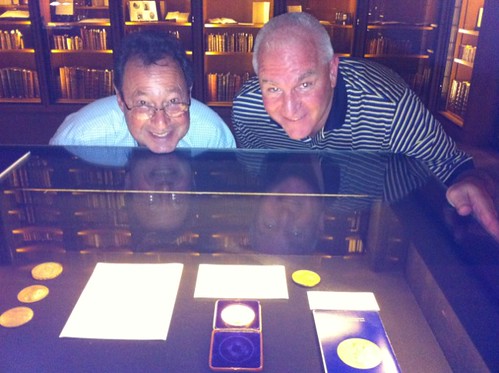
Dave Perkins and Alan Weinberg at the Boston Public Library
viewing the gold Washington Before Boston medal
From Marc Salzburg's exhibit at NGC of his own superb Massachusetts silver coinage type set (naturally in NGC slabs), to Stu Levine's multi-case bourse floor exhibit of his Comitia Americana medals, to Dave Sundman's profound exhibit of his own Massachusetts colonial silver, to Rex Stark's 1st prize-winning exhibit of immaculately enameled Morgan and Trade dollars (oh, that full face Wm H. Taft enameled dollar!).
And Dick Margolis' splendid array of 18th and 19th century Benjamin Franklin portrait medallions (a specialty of his for decades), John Sallay's seven-case exhibit of gold and silver school medals, many with incredible hand-engraved vignettes, to Tony Terranova's 1/2 bourse table offering of rare medals, to the heavy attendance viewing, over a week's time, of the Washington Before Boston original gold medal at the nearby Boston Public Library and the even more jaw-dropping medallic exhibit at the nearby Massachusetts Historical Society, there is definitely a substantial drift away from slabbed Morgan dollars and St Gaudens $20 gold pieces and even early type gold which can be seen at silly prices in bourse table after bourse table and really present no challenge except money..
This change in American numismatic appetite is abetted by the publication of delightful new reference books, following the Stack's Ford sales catalogues, such as John Adams' just-published Admiral Vernon medals book, Dave Bowers' American colonial coin encyclopedia, Eric Newman's new colonial currency book, Jaeger/Bowers' 100 Greatest American Medals and Tokens, George Kolbe's auction catalogues of the Ford and Stack's Family libraries, George Fuld's book on Washington Getz patterns, Coin World's prolific articles on the more obscure and historical items of American numismatics to Rory Rea's about-to-be-printed superb color plate book on bust quarter varieties.


Washington Oregon and Happy While United medals
Some things I saw at the ANA: John Kraljevich's land office business at his bourse table in an obscure part of the 2nd room of the bourse - not a U.S. federal coin in sight there - but rare and delightful tidbits including a momentary glimpse of an "out-of-the-woodwork" superb silver Libertas Americana medal before it quickly sold for a solid six figures; Joe O'Conner's for-exhibit-only 1799 bust dollar as it would have looked dropping from the dies- I'm reliably told it equals the very best of Eric Newman's bust dollars;
PCGS' bourse display of numerous gem proof - many red - half cents and large cents; the single decent grade "out-of-the-woodwork" 1793 Ameri. chain cent on the bourse floor, an EAC grade net VG-10 newly slabbed VF-20 selling for $40K; a middle grade 1652 New England NE shilling auctioning for a record-breaking total $431,500; a breathtaking $103,500 for a superbly leather-bound 1859 Geo. Washington portraits - a massive non-numismatic tome with an oval gold Jacob Perkins GW funeral gold medal under glass embedded in the cover selling to a Texas dealer reportedly representing a well-known Texas numismatic family; Jeff Shevlin's so-called dollar "sealed bid" Ostheimer I auction, a resounding success with some bids reduced in the multi-thousands of dollars.
Both Larry and Harvey Stack, now retired, were present walking on the bourse floor and you don't know realize how much they have been missed from the hobby until you see them.
And in 55 years of collecting I think that the highlight (apart from attending all of the John Ford Stack's auctions), was my visit to the Massachusetts Historical Society, where curator Anne Bentley (an unusual museum curator in that she has enthusiasm for collectors & an intense interest and knowledge of the numismatic contents of MHS' Appleton and Storer, etc collections) and collector/author John Adams mounted a one-time multi-cased exhibit of the rarest and superbly conditioned American medals I've seen.
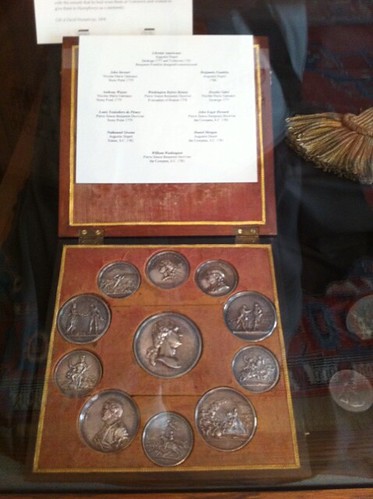
George Washington's set of silver Comitia Americana medals
WOW!
Such as a gold George Washington Manly original striking, a dreams-are-made- of 1764 Geo. III Happy While United silver peace medal, the original cased set of Comitia Americana silver medals presented to George Washington and later owned by Daniel Webster - minus the silver John Paul Jones medal which was lost in postal transit and reportedly even discarded with shipping materials! And a unique 1652 NE threepence.
But, for me and perhaps E-Sylum readers, a supreme highlight was collector Charles Anthon's "souvenir" hand-engraved 1867 seated dollar with a reverse engraved inscription celebrating Anthon's heavy buying at the Woodward Mickley auction. What numismatic history!
Sadly, MHS' own Massachusetts silver colonial coinage is "bare bones" due to a prior curator unwisely auctioning their Massachusetts colonial silver coinage to raise building funds in the early 1970's. Perhaps a collector reading this will correct the situation so that his name will live on in history as Appleton's and Storer's does.
However, there were some negatives about the show:
A second bourse room, walled off from the normal collector traffic flow and the "main" bourse room which was, throughout the show, notably less-well attended. There had to be repeated public address announcements that there was a 2nd bourse room and still that didn't work as the main entrance "tunnel" to the 2nd bourse room was visibly blocked by a huge ANA and Smithsonian exhibit and that's all you initially saw as you walked thru the "tunnel".
Most dealers I spoke with in both bourse rooms bitterly complained that the solid room wall separating the two bourse rooms was not clearly evident on the contract map and verbally "minimized" when bourse dealer inquiries came in about this 2nd bourse room.
ANA's traditional Sunday bourse closing is now closing on Saturday resulting in perhaps 40% of the dealers closed and gone by 3 PM Saturday.
The two pre-ANA's were pretty much a waste of time in my experience and according to just about everyone I spoke with, the Aiello Radisson show being somewhat more interesting and collector-oriented. Which probably does not prove promising for next year's Chicago ANA-sponsored "pre-ANA dealers -only" show.
PNG Day was much too long- it normally ranges from 10 AM to 3 PM with ANA bourse set-up starting at 4 PM but PNG Day was a full day in Boston. Which cut down on ANA bourse hours - that bourse opening at 1 PM the following day instead of the normal 10 AM - in addition to Sunday being eliminated.
The ANA exhibits in two rooms were largely superb in content but miserably lighted along the exhibit room walls - Rex Stark's enameled dollars, perhaps deservedly first place, were in almost total darkness while in the center of each exhibit room an entire row of empty tables (for lack of more exhibitors such as I) sat totally and embarrassingly empty but extremely well-lighted. What was the exhibit chairman thinking?
Speaking of lighting, what was the ANA thinking when the C4-sponsored colonial coin exhibit, including two superb New York City collections which included a superb Standish Barry 3d , an Unc Excelsior 1787 cent and an Unc American Congress Fugio cent, were simply not viewable in dark, unlighted display cases which only needed clip-on lamps? So many people negatively commented on this.
A bourse floor "dust-up" between two New York City longtime foe numismatic dealers which was quickly and quietly moved outside by Brueggeman security.
Sadly (but inevitably as all things change), longtime ANA Convention Coordinator Brenda Bishop is leaving her ANA employment this week for a new career in health industry expos, for a higher salary and less stress and work.
The choice of venue - Boston - is one of the most delightful cities I've ever visited. Wonderful eating opportunities, great museums, great public transportation, parks, a centrally -located lake, beautiful and plentiful college girls (yes, I still look!) and a thriving restaurant and bar nightlife. The Sheraton was nice and connected to a food court with an inexpensive Au Bon Pain restaurant, the site of delicious and varied breakfasts and lunches by numerous ANA attendees and dealers. Anyone who ate the overpriced convention center food ...
Makes you wonder why this is only the 3rd ANA convention in Boston since 1973. A wonderful week steeped in numismatics!
Thanks again to Alan, Joel, Dick, Dennis and Pete for their great accounts of the show, and Nathan and Dan for their excellent photos. Let's hear from more of you next week - what were other highlights from a numismatic literature and research standpoint? -Editor
THE BOOK BAZARRE
A FEW UPCOMING SEPTEMBER 16, 2010 AUCTION HIGHLIGHTSClassic Original Die Studies on Ancient Greek Coins, Including:
- Herzfelder on Rhegium, Regling on Terina, Boehringer on Syracuse,
- Calciati on Sicily, May on Ainos, Ravel on Corinth, Svoronos on Athens,
- Seltman on Olympia, Le Rider and Svoronos on Crete, Cahn on Knidos,
- Lederer on Nagidos, Naville on Cyrene and Svoronos on the Ptolemies.
(614) 414-0855 • df@numislit.com • GFK@numislit.com
QUIZ ANSWER: MONOGRAMS OF AMERICAN COIN AND MEDAL ARTISTS
Pete Smith writes:
Your question about artist monograms proved to be a challenge for me and I am not convinced that I found the right answers.
1. The letters in the monogram suggest Anthony de Francisci. However, this is not the monogram found on the Peace Dollar. I could not find an illustration of a medal with this monogram.
2. This one was easy and represents John Flanagan although he used a variety of monograms on his medals.
3. This looks quite a bit like the monogram for Laura Gardin Fraser although her monogram usually has a more prominent 'L'.
4. Of course I immediately thought of Hieronymus Holzschuber but I could not find a medal in my collection with his monogram. Next I thought of Henry Herrick but his name is on the Mint Medal without a monogram. I found a reference to a Henry Hering "HH" monogram on the base of a sculpture but I have not found it on a coin or medal.
Obviously there is a need for a reference on such monograms and I look forward to buying a copy later this week.
To read the earlier E-Sylum article, see: NEW BOOK: MONOGRAMS OF AMERICAN COIN AND MEDAL ARTISTS (www.coinbooks.org/esylum_v13n32a04.html)
GROUSE HUNTING SEASON: MORE ON AUDUBON'S FIRST ENGRAVED ILLUSTRATION
Andrew Hurle of Australia writes:
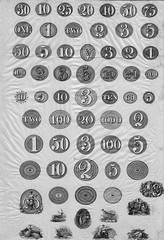 Can't say I share the fuss about the engraved grouse, but for those who might be interested there is at least one other impression of the bird. This might make it the 7th extant I suppose. Given it's grouse-hunting season perhaps these birds will indeed start popping up everywhere.
Can't say I share the fuss about the engraved grouse, but for those who might be interested there is at least one other impression of the bird. This might make it the 7th extant I suppose. Given it's grouse-hunting season perhaps these birds will indeed start popping up everywhere.
It is on another specimen sheet that I assume comes from Fairman, Draper & Underwood although there is no attribution visible on the paper. I've put an image and detail at:
flickr.com/gp/40145340@N03/oxX13y
flickr.com/gp/40145340@N03/dG4gA2
Is the leaping deer as famous as the grouse? Perhaps not.
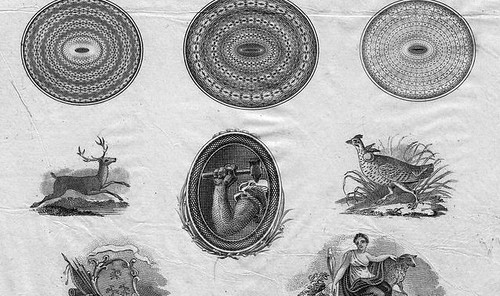
To read the earlier E-Sylum article, see: MORE ON AUDUBON'S FIRST ENGRAVED ILLUSTRATION (www.coinbooks.org/esylum_v13n32a07.html)
IS IT REAL? A 1913 DENVER MINT SHIPPING CRATE
Ron Pope writes:
In response to the inquiry about the wooden Buffalo nickel box, I have had one for several years and I feel it's some kind of modern reproduction. I also feel that the eBay seller of this item is a master at hype and fabrication-the only thing he stated that's true is the fact that one did sell for $2500 a few years ago. (I paid $150 for mine - they usually sell for around $200. I also have one with an 1887-CC Morgan Dollar on it that has to be a fabrication-no such coins exist!)
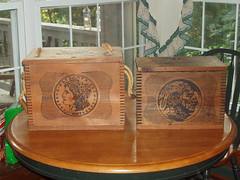
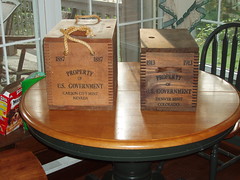
One reason I feel it's a modern production is the spelling of the word "PLURIBUS" on the box-"PURRIS." I seriously doubt that would be the case if it was a true US Mint product.
It makes for a very interesting display and conversation piece but an original coin box from the Mint? I don't think so.
To read the original E-Sylum article, see: IS IT REAL? A 1913 DENVER MINT SHIPPING CRATE (//www.coinbooks.org/esylum_v13n32a20.html)
RESEARCHING THE COPYRIGHT STATUS OF BOOKS
Ben Keele writes:
I saw this paper and thought it might be useful for some E-Sylum readers who are trying to ascertain the copyright status of books. The paper's author is a recognized expert on copyright related to libraries and higher education, so while the paper is oriented for academics, this is going to be one of the more detailed and authoritative accounts out there.
In the course of many projects you might need to determine whether a particular book is in the public domain or is still protected by copyright. If protected, your ability to reproduce, digitize, or use the book in some other way will be defined by law or permission from the rightsholder. If the work is in the public domain, it is free of copyright limits and restrictions.
Almost all original writings are eligible for copyright protection, and copyrights last a long time. They do eventually expire—which places the work in the public domain. This paper is intended to guide you through the exercise of tracking the duration of copyright on a specific book of your choosing, and in process will tell when it may have entered or will enter the public domain. The process may not be as easy as it should, but online resources now make it much simpler. The effort can also produce important and useful results.
To read the complete article, see:
Researching the Copyright Status of a Book:
Protected or Public Domain?
(copyright.columbia.edu/copyright/files/2010/08/
researching-the-copyright-status-of-books.pdf)
Ben adds:
Another good source is this chart by another librarian copyright expert. copyright.cornell.edu/resources/publicdomain.cfm .
MORE ON THE JUDGE JAMES P. GORTER MEDAL
With the help of reader Kay O. Freeman, Russ was able to contact the Judge's grandson and learn that he had one of the medals in gold. Now Russ has been able to obtain an image of that medal, pictured below along with the text of the medal's inscription. Thanks! The whereabouts of the bronze medal is still unknown. -Editor

COMMEMORATES THE SERVICE
OF
JAMES P. GORTER
JUDGE AND CHIEF JUDGE
OF
THE SUPREME BENCH
OF
BALTIMORE CITY
FROM
1907 - 1928
To read the earlier E-Sylum articles, see:
QUERY: JUDGE JAMES P. GORTER MEDALLION SOUGHT
(www.coinbooks.org/esylum_v13n25a17.html)
JUDGE JAMES P. GORTER MEDALLION FOUND
(www.coinbooks.org/esylum_v13n26a07.html)
QUERY: ROOSEVELT UNIVERSITY COURSE IN NUMISMATICS
Back in 1965, Art Kagin set up a course on numismatics to be given at Roosevelt University in Chicago. My memory is short on what happened. I was a lecturer in absentia in 1966 and Louis Eliasberg, Sr. was an Advisor in 1965-66. These latter two received a special silver medal made at the Franklin Mint by Frank Gasparro (these medals are not in the franklin Mint catalog).
I wonder if any of our readers can go back 45 years and remember any details of this course. Who participated, and why did it cease after one year? The Franklin Mint issued an alumni Roosevelt medal for the course, which had on the reverse "Inaugurated September 29, 1965". These are listed in catalog, with 900 struck in silver clad and 700 in Frankinium--but rarely turn up on eBay.
Were there articles about the course in either Numismatic News or Coin World? Help appreciated.
TOM DELOREY CONGRATULATES DAVID T. ALEXANDER
Tom DeLorey writes:
Kudos to David T. Alexander on receiving the Burnett Anderson Memorial Award! An overdue tribute to a prodigious career!
P.S.: This comment has nothing to do with the fact that David was Best Man at my wedding 24 years ago. We spent several years chained to the same oar at Coin World, back when the world was young!!!
THE BOOK BAZARRE
TOYOKORO, JAPAN GIVES GOLD OBAN COIN TO SISTER CITY
The municipality has received a historic fine gold coin from representatives of Toyokoro, Japan during a sister city delegation visit.
Over the past week, students and dignitaries from Summerland's sister city of Toyokoro were in Summerland for an exchange during the past week. In fall, a Summerland delegation will visit Toyokoro.
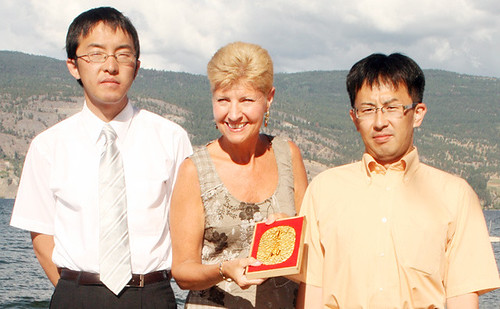
On Monday evening, at the municipal council meeting, Mayor Janice Perrino received the Tensho Oban coin from Manabu Saitoh, Toyokoro's chief financial officer.
The coin was minted in 1588. It is an oval coin with a fine gold content of 70 to 74 per cent and it weights around 165 grams.
The coin was created by Toyotomi Hideyoshi, Japan's most powerful feudal lord in the late 16th century. Hideyoshi minted a series of gold and slver coins from 1573 to 1592.
The coin is stamped with emblems of paulownia on both sides as a guarantee of its quality. Its weight and the name and signature of the mint official were written on the coin in black ink calligraphy.
The coin was rarely exchanged in daily transactions. instead, it was given as a reward or gift to the Imperial Family, aristocrats or samurai warriors. It was also used as a form of currency as merchants who imported silk and porcelain from China accepted the coin as a means of payment.
Mayor Janice Perrino receives a Tensho Oban gold coin from Fumito Miyake, left and Manabu Saitoh of Toyokoro, Japan. The 165-gram coin, minted in 1588, is traditionally given as a reward or gift to the Imperial Family, aristocrats or samurai warriors.
To read the complete article, see:
Ceremonial coin presented
(www.bclocalnews.com/okanagan_similkameen/summerlandreview
/news/100479414.html)
GOLD MNAIEION OF PTOLEMY V UNEARTHED IN ISRAEL
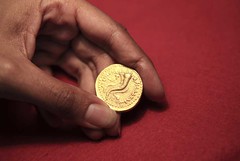 The coin, which apparently served ritual purposes, depicts a queen — apparently Arsinoë II — wife of her brother Ptolemy II
The coin, which apparently served ritual purposes, depicts a queen — apparently Arsinoë II — wife of her brother Ptolemy II
An extremely rare 2200-year old gold coin was uncovered recently in the excavations of the University of Michigan and University of Minnesota at Tell Kedesh in Israel near its Lebanese border. The coin was minted in Alexandria by Ptolemy V in 191 BCE and bears the name of the wife of Ptolemy II, Arsinoë Philadephus (II).
According to Dr. Donald T. Ariel, head of the Coin Department of the Israel Antiquities Authority, “This is an amazing numismatic find. The coin is beautiful and in excellent preservation. It is the heaviest gold coin with the highest contemporary value of any coin ever found in an excavation in Israel.

The coin weighs almost one ounce (27.71 grams), while most ancient gold coins weighed 4.5 grams. In Ariel's words, “This extraordinary coin was apparently not in popular or commercial use, but had a symbolic function. The coin may have had a ceremonial function related to a festival in honor of Queen Arsinoë, who was deified in her lifetime. The denomination is called a mnaieion, meaning a one-mina coin, and is equivalent to 100 silver drachms, or a mina of silver.
The obverse (‘head') of the coin depicts Arsinoë II Philadelphus. The reverse (‘tail') depicts two overlapping cornucopias (horns-of-plenty) decorated with fillets. The meaning of the word Philadelphus is brotherly love. Arsinoë II, daughter of Ptolemy I Soter, was married at age 15 to one of Alexander the Great's generals, Lysimachus, king of Thrace. After Lysimachus' death she married her brother, Ptolemy II, who established a cult in her honor. This mnaieion from Tel Kedesh attests to the staying power of the cult, since the coin was minted a full 80 years after the queen's death.
According to Ariel, “It is rare to find Ptolemaic coins in Israel dating after the country came under Seleucid rule in 200 BCE. The only other gold Ptolemaic coin from an excavation in Israel (from `Akko) dates from the period of Ptolemaic hegemony, in the third century BCE, and weighs less than two grams.”
To read the complete article, see: Extremely Rare 2,200-Year Old Gold Coin Uncovered by Excavations at Tell Kedesh (www.artdaily.org/index.asp?int_sec=2&int_new=39906)
EGYPTIAN MUSEUM EXHIBIT: COINS THROUGH THE AGES
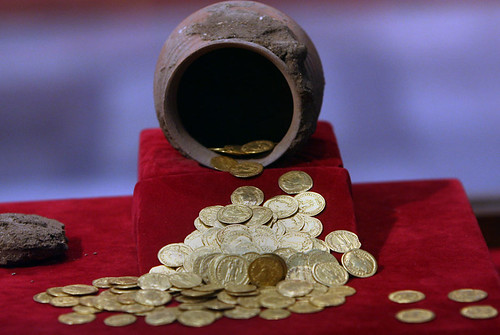
A collection of 171 golden coins from the Roman and Byzantine period are displayed at the exhibition Coins through the Ages Selected Collections from the Egyptian Museum in Cairo, Egypt, 10 August 2010. Dr Hawas, head of Egypts Supreme Council of Antiquities said that the exhibition contains a collection of coins dating back to different historical periods, including spare gold coins, silver and bronze and other antiques.
To read the complete article, see: The Best Photos of the Day (artdaily.org/index.asp?date=8/11/2010)
A GLIMPSE OF PAPER MONEY FROM THE TITANIC
One thing I don't like about Art Daily is that it uses different photos in the email than on the associated story on their web site. The currency photo below came from the email. -Editor
 The company with exclusive rights to salvage the Titanic is entitled to full compensation for artifacts worth about $110 million that it has recovered in a half-dozen perilous expeditions to the famous shipwreck, a federal judge has ruled.
The company with exclusive rights to salvage the Titanic is entitled to full compensation for artifacts worth about $110 million that it has recovered in a half-dozen perilous expeditions to the famous shipwreck, a federal judge has ruled.
However, U.S. District Judge Rebecca Beach Smith's ruling late Thursday did not determine how RMS Titanic Inc. will be paid. She said she could take up to a year to decide whether to give RMS title to the approximately 5,900 artifacts or sell them and turn the proceeds over to the company.
Meanwhile, RMS will retain possession of the items, which its Atlanta-based parent company Premier Exhibitions Inc. has been displaying in exhibitions around the world. The artifacts include pieces of china, ship fittings and personal belongings.
"The company is extremely pleased with the ruling, which reflects a thoughtful, deliberate approach to this case as well as the judge's deep concern over the long-term well-being of the Titanic artifacts," RMS attorney Brian Wainger said in a telephone interview.
The Titanic sank on its maiden voyage on April 12, 1912, killing more than 1,500 of the 2,228 passengers and crew. An international team led by oceanographer Robert Ballard located the wreckage on the North Atlantic floor about 400 miles off Newfoundland in 1985.
In her ruling, Smith praised RMS Titanic for taking substantial financial and physical risks and for going to great lengths to preserve the fragile artifacts. She said the company has devoted more than 500,000 hours of labor to salvaging, conserving and exhibiting the artifacts.
Smith noted that RMS had to invent tools to convert manned submersible vessels from research-only to salvage operations. For example, the company developed a vacuum system for collection of small items and a system that used diesel fuel-filled lift bags to recover a 15-ton section of hull — the largest artifact ever recovered from the deep ocean.
To read the complete article, see: Titanic Salvage Company Wins Award from Virginia Court (www.artdaily.org/index.asp?int_sec=2&int_new=39974)
BBC ARTICLE ON THE UNUSED U.S DOLLAR COINS
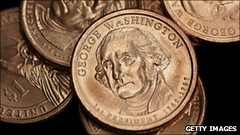 In hidden vaults across the country, the US government is building a stockpile of $1 coins. The hoard has topped $1.1bn - imagine a stack of coins reaching almost seven times higher than the International Space Station - and the piles have grown so large the US Federal Reserve is running out of storage space.
In hidden vaults across the country, the US government is building a stockpile of $1 coins. The hoard has topped $1.1bn - imagine a stack of coins reaching almost seven times higher than the International Space Station - and the piles have grown so large the US Federal Reserve is running out of storage space.
Americans won't use the coins, preferring $1 notes. But the US keeps minting them anyway, and the Fed estimates it already has enough $1 coins to last the next 10 years.
And at the current rate, the inventory will grow to $2bn (£1.3bn) by 2016, the Fed estimates.
The coins began to pile up in 2007 when a law went into effect creating a new series of $1 coins commemorating dead US presidents.
Congress passed the law creating the coins despite evidence that Americans never liked the $1 coin in the past.
Since the presidential coin programme began, the US government has spent an additional $30m to promote them but they still have not taken hold.
"We have tried every major idea that we can come up with, with limited success," US Mint Director Edmund Moy told a congressional panel last month.
And even some coin collectors dislike them.
"We've had any number of people over the years complain about receiving a dollar coin," says Tom DeLorey, a Chicago coin dealer.
Until the US phases out the $1 note or stops minting the coins, they will keep piling up in the vaults.
"People will grumble and [the coins] will be unpopular for a few months but then they'll get used to it," says David Lange, director of research for the Numismatic Guaranty Corporation, a service for coin collectors.
"It's that simple."
Or, in the bureaucratic language of Congress' investigative arm: "The most substantial barrier is the current widespread use of the dollar bill in everyday transactions."
To read the complete article, see: Why the US keeps minting coins people hate and won't use (www.bbc.co.uk/news/world-us-canada-10783019)
HEAD OF BANKNOTE FIRM DE LA RUE RESIGNS OVER PAPER QUALITY
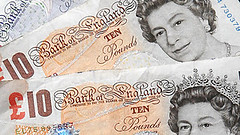 De La Rue's chief executive, James Hussey, resigned following a warning from the world's biggest printer of bank notes that sales would be hit by quality problems at one of its paper factories.
De La Rue's chief executive, James Hussey, resigned following a warning from the world's biggest printer of bank notes that sales would be hit by quality problems at one of its paper factories.
Last month, De La Rue, which makes banknote paper for more than 150 world currencies, warned that sales this year and in 2011 would be "materially lower" than expected after it suspended production at its paper factory in Overton, Hampshire for failing to meet quality standards.
"Mr Hussey's decision to resign follows the company's statement on 20 July 2010 in relation to certain quality and production irregularities at one of its paper production facilities and his belief that he must take responsibility for this," De La Rue said.
"The company continues to look into these irregularities in one of its paper production facilities, which the board considers to be of a serious nature."
To read the complete article, see:
De La Rue chief executive James Hussey resigns over paper quality problems
(www.telegraph.co.uk/finance/newsbysector/epic/
dlar/7940314/De-La-Rue-chief-executive-
James-Hussey-resigns-over-paper-quality-problems.html)
To read the earlier E-Sylum article, see: BANKNOTE PRINTER DE LA RUE HALTS PRODUCTION OVER PAPER QUALITY (www.coinbooks.org/esylum_v13n30a23.html)
DIRTY MONEY: BANKNOTES REFLECT NATIONAL WEALTH
 The richer the country, the cleaner its banknotes. This is the outcome of a recent study by the University of Wageningen in the Netherlands obtained by Gulf News.
The richer the country, the cleaner its banknotes. This is the outcome of a recent study by the University of Wageningen in the Netherlands obtained by Gulf News.
Dutch scientists examined 1,280 banknotes from 10 countries, among them Australia, China, New Zealand, Nigeria, Burkina Faso, the UK and the US.
The banknotes were collected from a range of food outlets, including shops and snack bars, said scientist Rijkelt Beumer. They were then subjected to a thorough examination to identify bacteria.
The researchers found a strong correlation between the number of bacteria per square centimetre on a banknote and a number of indicators of economic wealth in the various countries. The lower a country scores on the "index for economic independence", the more bacteria that were found on its banknotes, Beumer said.
However, the researchers only found low concentrations of pathogenic bacteria on the banknotes, and there was no evidence of alarming high numbers anywhere.
He said that the material used to produce the banknotes is also important. Cotton is used in most banknotes, such as the euro or the dollar. Although this initially makes it difficult for bacteria to take hold, the researchers only found a quarter of the bacteria on banknotes manufactured on a polymer substrate basis (used in countries with a hotter climate, such as Australia) as they did on banknotes made from a cotton-based material.
To read the complete article, see:
Banknotes reflect national wealth
(gulfnews.com/business/general/banknotes-reflect
-national-wealth-1.667167)
FEATURED WEB SITE: THE AMERICAN NUMISMATIC ASSOCIATION
This week's Featured Web Site is the American Numismatic Association.

The American Numismatic Association is a nonprofit educational organization dedicated to educating and encouraging people to study and collect money and related items. With nearly 33,000 members, the Association serves the academic community, collectors and the general public with an interest in numismatics.
The ANA helps all people discover and explore the world of money through its vast array of programs including its education and outreach, museum, library, publications, conventions and seminars.
www.money.org

